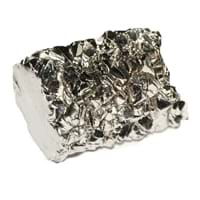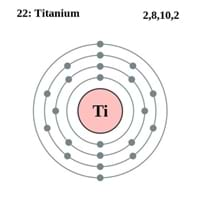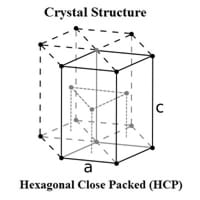Ti Element
Periodic Table
0
Symbol
Ti 0
Group Number
4 14
Period Number
4 4
Block
d block 0
Element Family
Transition Metal 0
CAS Number
7440326 49
Space Group Name
P63/mmc 0
Space Group Number
194.00 5
Facts
0
Interesting Facts
- The only metal which burns in Nitrogen is Titanium.
- Titanium is also known as corrosion resistant metal.
Sources
Found in Minerals, Mining 0
History
0
Who Discovered
W. Gregor & J. Berzelius 0
Discovery
In 1791 0
Abundance
0
Abundance In Universe
3 * 10-4 % 9
Abundance In Sun
~0.0004 % 9
Abundance In Meteorites
0.05 % 11
Abundance In Earth's Crust
0.66 % 7
Abundance In Oceans
0.00 % 15
Abundance In Humans
Not Available 0
Uses
0
Uses & Benefits
- Its alloys are used in spacecraft, aircraft and ammunition industry.
- Its pipes are used in distillation plants, submarines, hulls of big ships, etc.
Industrial Uses
Aerospace Industry, Automobile Industry, Chemical Industry, Electrical Industry, Electronic Industry 0
Medical Uses
Dentistry, Surgical Instruments Manufacturing 0
Other Uses
Alloys, Jewellery, Sculptures, Statues 0
Biological Properties
0
Toxicity
Non Toxic 0
Present in Human Body
Yes 0
In Blood
0.05 Blood/mg dm-3 16
In Bone
Not Available 0
Physical
0
Melting Point
1,660.00 °C 18
Boiling Point
3,287.00 °C 22
Appearance
0
Physical State
Solid 0
Color
Silvery Gray-White 0
Luster
Metallic 0
Hardness
0
Mohs Hardness
6.00 6
Brinell Hardness
716.00 MPa 15
Vickers Hardness
830.00 MPa 14
Speed of Sound
5,090.00 m/s 9
Optical Properties
0
Refractive Index
Not Available 0
Reflectivity
Not Available 0
Allotropes
No 0
α Allotropes
Not Available 0
β Allotropes
Not Available 0
γ Allotropes
Not Available 0
Chemical
0
Chemical Formula
Ti 0
Isotopes
0
Known Isotopes
23 16
Electronegativity
0
Pauling Electronegativity
1.54 26
Sanderson Electronegativity
1.09 20
Allred Rochow Electronegativity
1.32 23
Mulliken-Jaffe Electronegativity
Not Available 0
Allen Electronegativity
1.38 32
Electropositivity
0
Pauling Electropositivity
2.46 28
Ionization Energies
0
1st Energy Level
658.80 kJ/mol 39
2nd Energy Level
1,309.80 kJ/mol 53
3rd Energy Level
2,652.50 kJ/mol 41
4th Energy Level
4,174.60 kJ/mol 32
5th Energy Level
9,581.00 kJ/mol 5
6th Energy Level
11,533.00 kJ/mol 6
7th Energy level
13,590.00 kJ/mol 6
8th Energy Level
16,440.00 kJ/mol 8
9th Energy Level
18,530.00 kJ/mol 11
10th Energy Level
20,833.00 kJ/mol 15
11th Energy Level
25,575.00 kJ/mol 14
12th Energy Level
28,125.00 kJ/mol 14
13th Energy Level
76,015.00 kJ/mol 1
14th Energy Level
83,280.00 kJ/mol 2
15th Energy Level
90,880.00 kJ/mol 3
16th Energy Level
100,700.00 kJ/mol 4
17th Energy Level
109,100.00 kJ/mol 5
18th Energy Level
117,800.00 kJ/mol 6
19th Energy Level
129,900.00 kJ/mol 7
20th Energy Level
137,530.00 kJ/mol 9
21st Energy Level
Not Available 100
22nd Energy Level
Not Available 100
23rd Energy Level
Not Available 0
24th Energy Level
Not Available 0
25th Energy Level
Not Available 0
26th Energy Level
Not Available 0
27th Energy Level
Not Available 0
28th Energy Level
Not Available 0
29th Energy Level
Not Available 0
30th Energy Level
Not Available 0
Electrochemical Equivalent
0.45 g/amp-hr 70
Electron Work Function
4.33 eV 17
Other Chemical Properties
Chemical Stability, Ionization 0
Atomic
0
Atomic Number
22 84
Electron Configuration
[Ar] 3d2 4s2 0
Crystal Structure
Hexagonal Close Packed (HCP) 0
Crystal Lattice
HCP-Crystal-Structure-of-Titanium.jpg#100 0
Atom
0
Number of Protons
22 83
Number of Neutrons
26 62
Number of Electrons
22 83
Radius of an Atom
0
Atomic Radius
147.00 pm 34
Covalent Radius
160.00 pm 30
Van der Waals Radius
200.00 pm 28
Atomic Weight
47.87 amu 78
Atomic Volume
10.64 cm3/mol 46
Adjacent Atomic Numbers
0
Previous Element
60 0
Next Element
39 0
Valence Electron Potential
95.20 (-eV) 10
Lattice Constant
295.08 pm 61
Lattice Angles
π/2, π/2, 2 π/3 0
Lattice C/A Ratio
Not Available 0
Mechanical
0
Density
0
Density At Room Temperature
4.51 g/cm3 70
Density When Liquid (at m.p.)
4.11 g/cm3 49
Tensile Strength
434.00 MPa 9
Viscosity
Not Available 0
Vapor Pressure
0
Vapor Pressure at 1000 K
Not Available 0
Vapor Pressure at 2000 K
0.98 (Pa) 14
Elasticity properties
0
Shear Modulus
44.00 GPa 17
Bulk Modulus
110.00 GPa 15
Young's Modulus
116.00 GPa 18
Poisson Ratio
0.32 12
Other Mechanical Properties
Ductile 0
Magnetic
0
Magnetic Characteristics
0
Specific Gravity
4.51 58
Magnetic Ordering
Paramagnetic 0
Permeability
Not Available 0
Susceptibility
Not Available 0
Electrical Properties
0
Electrical Property
Poor Conductor 0
Resistivity
420.00 nΩ·m 12
Electrical Conductivity
0.02 106/cm Ω 42
Electron Affinity
7.60 kJ/mol 37
Thermal
0
Specific Heat
0.52 J/(kg K) 9
Molar Heat Capacity
25.06 J/mol·K 44
Thermal Conductivity
21.90 W/m·K 43
Critical Temperature
Not Available 0
Thermal Expansion
8.60 µm/(m·K) 45
Enthalpy
0
Enthalpy of Vaporization
429.00 kJ/mol 15
Enthalpy of Fusion
15.48 kJ/mol 19
Enthalpy of Atomization
468.60 kJ/mol 15
Standard Molar Entropy
27.30 J/mol.K 56
|
||
|
||
|









